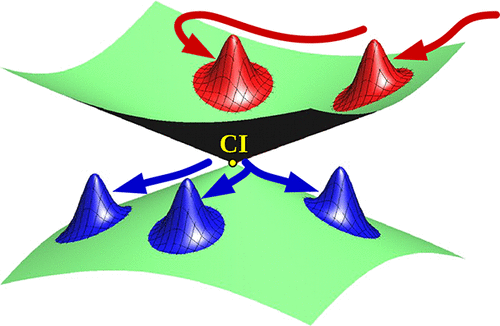当前位置:
X-MOL 学术
›
J. Phys. Chem. A
›
论文详情
Our official English website, www.x-mol.net, welcomes your feedback! (Note: you will need to create a separate account there.)
Nonadiabatic Quantum Dynamics with Frozen-Width Gaussians
The Journal of Physical Chemistry A ( IF 2.9 ) Pub Date : 2018-05-21 00:00:00 , DOI: 10.1021/acs.jpca.8b03404 Loïc Joubert-Doriol 1, 2 , Artur F. Izmaylov 1, 2
The Journal of Physical Chemistry A ( IF 2.9 ) Pub Date : 2018-05-21 00:00:00 , DOI: 10.1021/acs.jpca.8b03404 Loïc Joubert-Doriol 1, 2 , Artur F. Izmaylov 1, 2
Affiliation

|
We review techniques for simulating fully quantum nonadiabatic dynamics using the frozen-width moving Gaussian basis functions to represent the nuclear wave function. A choice of these basis functions is primarily motivated by the idea of the on-the-fly dynamics that will involve electronic structure calculations done locally in the vicinity of each Gaussian center and thus avoiding the “curse of dimensionality” appearing in large systems. For quantum dynamics involving multiple electronic states there are several aspects that need to be addressed. First, the choice of the electronic-state representation is one of most defining in terms of formulation of resulting equations of motion. We will discuss pros and cons of the standard adiabatic and diabatic representations as well as the relatively new moving crude adiabatic (MCA) representation. Second, if the number of electronic states can be fixed throughout the dynamics, the situation is different for the number of Gaussians needed for an accurate expansion of the total wave function. The latter increases its complexity along the course of the dynamics and a protocol extending the number of Gaussians is needed. We will consider two common approaches for the extension: (1) spawning and (2) cloning. Third, equations of motion for individual Gaussians can be chosen in different ways, implications for the energy conservation related to these ways will be discussed. Finally, to extend the success of moving basis approaches to quantum dynamics of open systems we will consider the Nonstochastic Open System Schrödinger Equation (NOSSE).
中文翻译:

冻结宽度高斯方程的非绝热量子动力学
我们回顾了使用冻结宽度移动高斯基函数表示核波函数来模拟完全量子非绝热动力学的技术。这些基本功能的选择主要是通过动态动力学的思想来进行的,该动力学涉及在每个高斯中心附近局部进行电子结构计算,从而避免了大型系统中出现的“维数诅咒”。对于涉及多个电子态的量子动力学,有几个方面需要解决。首先,就形成的运动方程而言,电子状态表示的选择是最定义之一。我们将讨论标准绝热和绝热表示形式以及相对较新的移动原油绝热(MCA)表示形式的利弊。其次,如果在整个动力学过程中电子状态的数量可以固定,那么对于精确扩展总波函数所需的高斯数量,情况就不同了。后者随着动力学的发展而增加了其复杂性,并且需要扩展高斯数量的协议。我们将考虑两种常见的扩展方法:(1)生成和(2)克隆。第三,可以以不同的方式选择单个高斯运动方程,将讨论与这些方式相关的节能意义。最后,为了将移动基础方法的成功扩展到开放系统的量子动力学,我们将考虑非随机开放系统Schrödinger方程(NOSSE)。对于精确扩展总波函数所需的高斯数量,情况则有所不同。后者随着动力学的发展而增加了其复杂性,并且需要扩展高斯数量的协议。我们将考虑两种常见的扩展方法:(1)生成和(2)克隆。第三,可以以不同的方式选择单个高斯运动方程,将讨论与这些方式相关的节能意义。最后,为了将移动基础方法的成功扩展到开放系统的量子动力学,我们将考虑非随机开放系统Schrödinger方程(NOSSE)。对于精确扩展总波函数所需的高斯数量,情况则有所不同。后者随着动力学的发展而增加了其复杂性,并且需要扩展高斯数量的协议。我们将考虑两种常见的扩展方法:(1)生成和(2)克隆。第三,可以以不同的方式选择单个高斯运动方程,将讨论与这些方式相关的节能意义。最后,为了将移动基础方法的成功扩展到开放系统的量子动力学,我们将考虑非随机开放系统Schrödinger方程(NOSSE)。后者随着动力学的发展而增加了其复杂性,并且需要扩展高斯数量的协议。我们将考虑两种常见的扩展方法:(1)生成和(2)克隆。第三,可以以不同的方式选择单个高斯运动方程,将讨论与这些方式相关的节能意义。最后,为了将移动基础方法的成功扩展到开放系统的量子动力学,我们将考虑非随机开放系统Schrödinger方程(NOSSE)。后者随着动力学的发展而增加了其复杂性,并且需要扩展高斯数量的协议。我们将考虑两种常见的扩展方法:(1)生成和(2)克隆。第三,可以以不同的方式选择单个高斯运动方程,将讨论与这些方式相关的节能意义。最后,为了将移动基础方法的成功扩展到开放系统的量子动力学,我们将考虑非随机开放系统Schrödinger方程(NOSSE)。
更新日期:2018-05-21
中文翻译:

冻结宽度高斯方程的非绝热量子动力学
我们回顾了使用冻结宽度移动高斯基函数表示核波函数来模拟完全量子非绝热动力学的技术。这些基本功能的选择主要是通过动态动力学的思想来进行的,该动力学涉及在每个高斯中心附近局部进行电子结构计算,从而避免了大型系统中出现的“维数诅咒”。对于涉及多个电子态的量子动力学,有几个方面需要解决。首先,就形成的运动方程而言,电子状态表示的选择是最定义之一。我们将讨论标准绝热和绝热表示形式以及相对较新的移动原油绝热(MCA)表示形式的利弊。其次,如果在整个动力学过程中电子状态的数量可以固定,那么对于精确扩展总波函数所需的高斯数量,情况就不同了。后者随着动力学的发展而增加了其复杂性,并且需要扩展高斯数量的协议。我们将考虑两种常见的扩展方法:(1)生成和(2)克隆。第三,可以以不同的方式选择单个高斯运动方程,将讨论与这些方式相关的节能意义。最后,为了将移动基础方法的成功扩展到开放系统的量子动力学,我们将考虑非随机开放系统Schrödinger方程(NOSSE)。对于精确扩展总波函数所需的高斯数量,情况则有所不同。后者随着动力学的发展而增加了其复杂性,并且需要扩展高斯数量的协议。我们将考虑两种常见的扩展方法:(1)生成和(2)克隆。第三,可以以不同的方式选择单个高斯运动方程,将讨论与这些方式相关的节能意义。最后,为了将移动基础方法的成功扩展到开放系统的量子动力学,我们将考虑非随机开放系统Schrödinger方程(NOSSE)。对于精确扩展总波函数所需的高斯数量,情况则有所不同。后者随着动力学的发展而增加了其复杂性,并且需要扩展高斯数量的协议。我们将考虑两种常见的扩展方法:(1)生成和(2)克隆。第三,可以以不同的方式选择单个高斯运动方程,将讨论与这些方式相关的节能意义。最后,为了将移动基础方法的成功扩展到开放系统的量子动力学,我们将考虑非随机开放系统Schrödinger方程(NOSSE)。后者随着动力学的发展而增加了其复杂性,并且需要扩展高斯数量的协议。我们将考虑两种常见的扩展方法:(1)生成和(2)克隆。第三,可以以不同的方式选择单个高斯运动方程,将讨论与这些方式相关的节能意义。最后,为了将移动基础方法的成功扩展到开放系统的量子动力学,我们将考虑非随机开放系统Schrödinger方程(NOSSE)。后者随着动力学的发展而增加了其复杂性,并且需要扩展高斯数量的协议。我们将考虑两种常见的扩展方法:(1)生成和(2)克隆。第三,可以以不同的方式选择单个高斯运动方程,将讨论与这些方式相关的节能意义。最后,为了将移动基础方法的成功扩展到开放系统的量子动力学,我们将考虑非随机开放系统Schrödinger方程(NOSSE)。



























 京公网安备 11010802027423号
京公网安备 11010802027423号